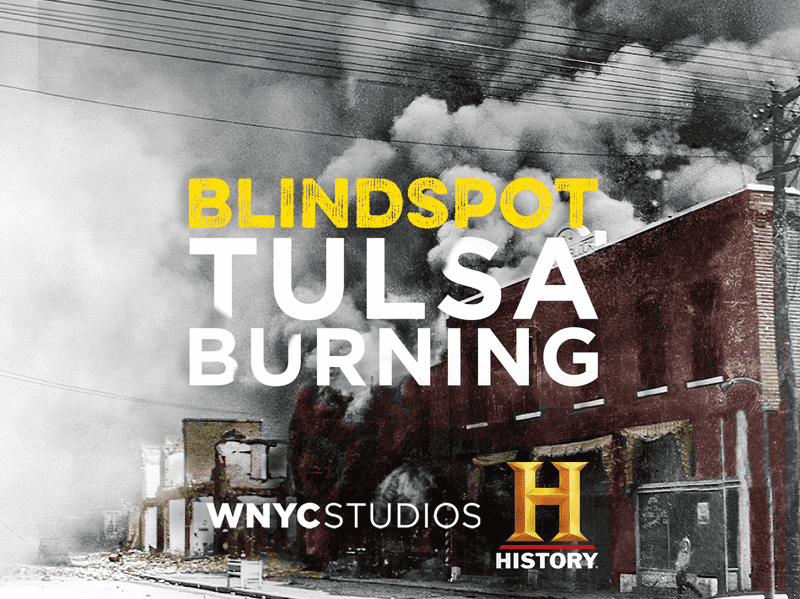Collection: Tulsa Burning: Blindspot, Hosted by KalaLea (2021) Return to Group
-
Scroll below to find Tulsa Burning: Blindspot, Hosted by KalaLea,
a podcast with six episodes and transcripts in the documents below.
Add as many comments and replies as you can to each of the documents as you read and listen.
Hit the subscribe button for this collection (top right) to get notifications when other readers make comments.
Go back to each document re-read, read others' comments, and add to the conversation!

On May 31, 1921, the Greenwood District of Tulsa, Oklahoma was a thriving city within a city -- a symbol of pride, success and wealth. The next morning, it was ashes. What happened remained a secret for almost a century.
Voices featured in this trailer include: KalaLea, Chief Eguwale Amusan, Quraysh Ali Lansana, Raven Majia Williams, and Dr. Tiffany Crutcher.
Click here to see a few specific suggestions about what and how to annotate.
Watch this GIF to see five suggestions for responding.

-
230 Comments
Episode 1: The Past Is Present: Blindspot


This episode contains descriptions of graphic violence and racially offensive language.
On May 31, 1921, Tulsa, Oklahoma’s Greenwood District was a thriving Black residential and business community — a city within a city. By June 1, a white mob, with the support of law enforcement, had reduced it to ashes. And yet the truth about the attack remained a secret to many for nearly a century.
Chief Egunwale Amusan grew up in Tulsa — his grandfather survived the attack — and he’s dedicated his life to sharing the hidden history of what many called “Black Wall Street.” But Dr. Tiffany Crutcher, also a descendant of a survivor, didn’t learn about her family history or the massacre until she was an adult. Together, they’re trying to correct the historical record. As Greenwood struggles with the effects of white supremacy 100 years later, people there are asking: in this pivotal moment in American history, is it possible to break the cycle of white impunity and Black oppression -
137 Comments
Episode 2: The Rise of Greenwood: Blindspot


The people beyond Greenwood’s borders ensured that the neighborhood could not prosper for long. To understand how and why, we travel back to the Trail of Tears and the forced resettlement of five Native American tribes. We examine the racist laws and policies that shaped the area. Despite Jim Crow segregation, the district flourished -- it even came to be called “Black Wall Street.” “The story of Greenwood is so complex,” says writer Victor Luckerson. “There's so much tragedy and trauma as part of it, but also so much inspiration.” We also meet the journalist A.J. Smitherman, legendary publisher of The Tulsa Star (one of the first Black daily newspapers in the United States) and a fierce advocate for his community.
-
158 Comments
Episode 3: The Two Wars: Blindspot


This episode contains descriptions of graphic violence and racially offensive language.
When the U.S. entered World War I, W.E.B. DuBois and Tulsa lawyer B.C. Franklin saw a rare opportunity: Black Americans serving in the military might finally persuade white citizens that they deserved equal respect. But the discrimination they faced in civilian life continued in the trenches and on the homefront. After the war, white mobs plundered and burned Black neighborhoods throughout the country. And during the “Red Summer” of 1919, whites lynched more than 80 people, including Black veterans. Groups like the African Blood Brotherhood responded by urging people to defend themselves — with force, if necessary. On May 31, 1921 the fight arrived in Greenwood.
-
119 Comments
Episode 4: The Massacre: Blindspot


This episode contains descriptions of graphic violence and racially offensive language.
Over two days — May 31 and June 1, 1921 — a mob of white attackers systematically looted Greenwood and burned it to the ground. Estimates vary, but reports say the marauders killed 100 to 300 people; and they left thousands homeless, faced with the daunting task of rebuilding. We experience the attack through the eyes of lawyer B.C. Franklin and reporter Mary Elizabeth Jones Parrish — each left personal, comprehensive written accounts of those terrible days.
We also hear how their experiences have affected their descendants. “They had a lot of family trauma,” says Parrish’s great-granddaughter Anneliese Bruner. “Some of these are behaviors that arise because of the chaos that is passed down from generation to generation. The responses and the symptoms are just the outward manifestation of the suffering that people are enduring and carrying around.
-
124 Comments
Episode 5: The Body: Blindspot


This episode contains descriptions of graphic violence.
Ignored, erased, silenced… But Greenwood’s trauma from 1921 persists. Resmaa Menakem — a therapist and expert on healing from conflict and violence — explains how generations of people pass down the experiences of historical events, and how racialized trauma affects us all, no matter our skin color. He and KalaLea ask, how might healing happen for the descendants of survivors and perpetrators of the massacre?
-
97 Comments
Episode 6: The Lesson: Blindspot


The centennial of the massacre attracted international coverage; camera crews, T-shirt vendors, and even a visit from President Joe Biden. It seemed as though all this attention might ensure that history finally, would never be forgotten. But a month later some Tulsans worry that a backlash has begun. The city’s mayor and other elected officials have spoken against reparations for victims of the massacre and their descendents. A new law in Oklahoma limits how teachers can teach the massacre in schools. "If you care about the history of America's Black victims of racial violence,” says educator Karlos Hill, “You live in the world differently than if you are indifferent or simply ignorant about it."

